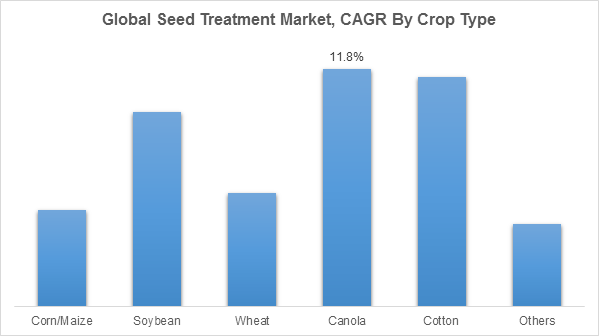December 2018: Adroit Market Research studied Global Seed Treatment Market Size, by Crop Type (Corn/Maize, Soybean, Wheat, Canola, Cotton, Others), by Treatment (Insecticides, Fungicides, Nonchemical and Other chemical treatment) and by Region (North America, Europe, Asia Pacific, Latin America and Middle East & Africa). The global seed treatment market analysis includes industry trends, opportunities, drivers and restrains. The study also shows value chain analysis. This coupled with competitive landscape of the major players in the global seed treatment market, we have estimated the market till 2025.
The global seed treatment market is expected to grow at a CAGR of 11.2% during the forecast period. The market grew as farmers are adopting to seed treatments to improve the quality and to increase the crop yield to meet the demand of the growing population. Further to protect the farmers and their crops, governments in the agriculture-based economy such as India are offering subsidiaries in seed treatment driving the growth of the global seed treatment market.
Seed treatment is the key element in deciding the agriculture sector’s output and thus many players in the market are investing heavily in research and development of new formulation in the global seed treatment market. Developments of new seed treatments formulations is anticipated to boost the market growth of global seed treatment during the forecast period. For instance, in 2017, Bayer CropScience had launched new fungicide Raxil Easy, a product which controls the growth of loose smut disease in crops such as wheat. The product was launched to protect the wheat crop in India during the rabi planting season.
Trends such as seed coating are expected to drive the growth of the global seed treatment market during the forecast period. Seed coating is a process under which different chemicals such as fungicides, insecticides and other protecting agents are used to externally coat the seed to prevent any fungal, bacterial or pathogen attack. Examples of seed coating are film coating and artificial polymer coating.
Is projected to be the largest market accounting to 33% share growing at a CAGR of 10.9% in the global seed treatment market by 2025. Seed treatment in corn is used to control seasonal pests and diseases. The use of seed treatments in corn is projected to maximize the plant’s stand, yield and vigor. Hence many farmers worldwide are projected to use seed treatments driving the growth of the global seed treatment market. For instance, Poncho 1250 + VOTiVO FST/IST/NST includes a 1250* rate of Poncho insecticide (clothianidin) a product of the company Du Point which provides suppression of black cutworm and also protect the crops from rootworm attach at low-pressure levels in the global seed treatment market.

Canola is projected to grow with the fastest CAGR of 11.8% during the forecast period in the global seed treatment market as new formulations are now being launched. For instance, Bayer CropScience a player in global seed treatment market is now offering Jockey Stayer a quinazoline-triazole fungicide for canola seed treatment. The active ingredients are 167 g/L fluquinconazole that protect the canola crop.
Insecticides are projected to dominate the market share at 53% during the forecast period in the global seed treatment market. The segment is projected to grow steadily as many players in the global seed treatment are investing broadly in R&D to bring in the new formulation to treat some of the largest crop production such as corn, soy and wheat. Non-chemical treatment types are expected to grow at the fastest CAGR of 11.8% in the global seed treatment market.
Asia Pacific is projected to grow with the fastest CAGR of 13.4% in the global seed treatment market. The region is expected to grow as the agriculture sector in India and China are projected to boom during the forecast period coupled increased awareness about seed treatments in farmers. Further, the government of major countries are implementing programs that offer seed treatments at a subsidized rate, driving the growth of the seed treatment market in the region. For instance, the scheme by the government of India named Development and Strengthening of Infrastructure Facilities for Production and Distribution of Quality Seeds is offering seed at subsidized rate. North America is projected to continue its dominance as the region is a mature market and the players are projected to bring new formulations continuously boosting the region growth in the global seed treatment market.
Players such as Bayer CropScience, BASF SE, DuPont de Nemours and Company, Sumitomo Chemical Company, BrettYoung Limited, Advanced Biological Marketing, Chemtura Corporation, Syngenta AG, Valent U.S.A. Corporation are projected to have an impact in the global seed treatment market.
Segment overview of global seed treatment market
- Crop type Overview, 2015-2025 (USD billion)
- Corn/Maize
- Soybean
- Wheat
- Canola
- Cotton
- Others
- Treatment type Overview, 2015-2025 (USD billion)
- Insecticides
- Fungicides
- Nonchemical
- Other chemical treatment
- Regional Overview, 2015-2025 (USD billion)
- North America
- U.S.
- Canada
- Europe
- France
- Germany
- Spain
- Rest of Europe
- Asia Pacific
- India
- Japan
- China
- Rest of Asia Pacific
- Latin America
- Brazil
- Mexico
- Rest of Latin America
- Middle East & Africa
- UAE
- South Africa
- Rest of Middle East and Africa
- North America


